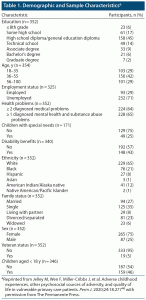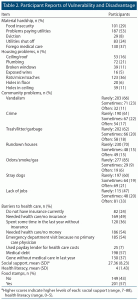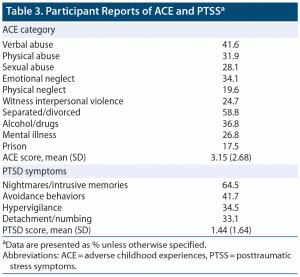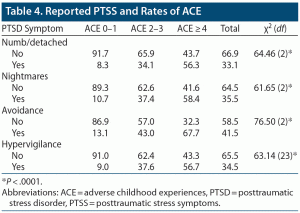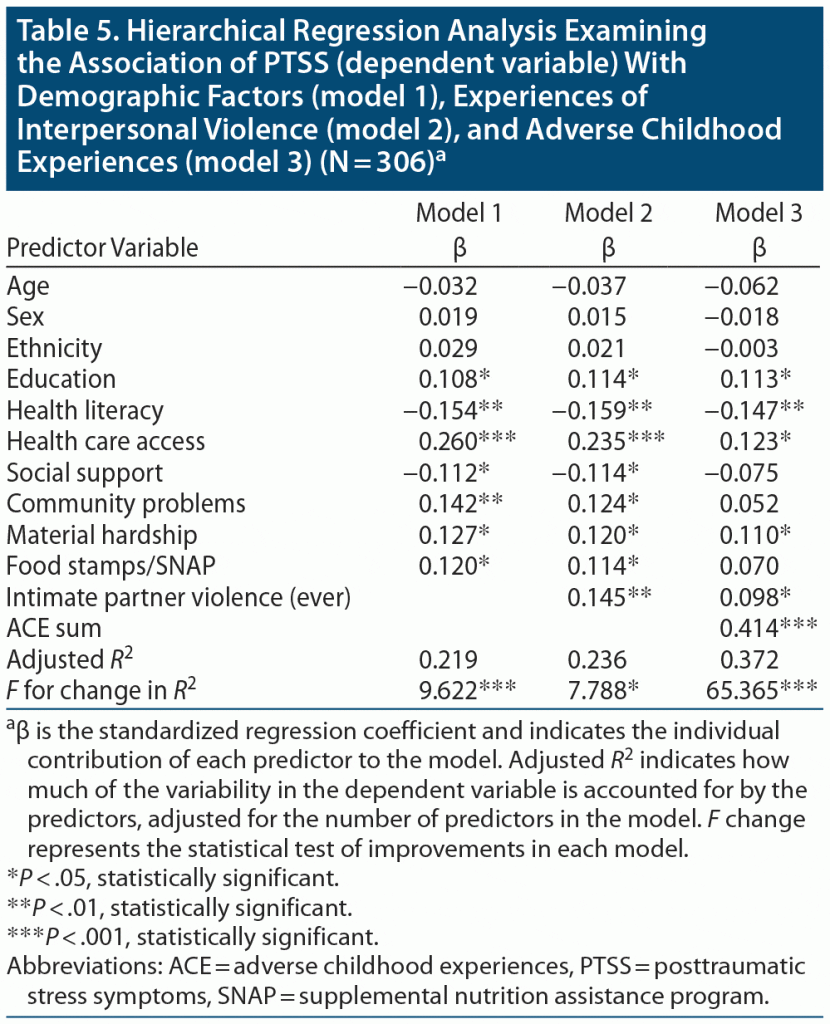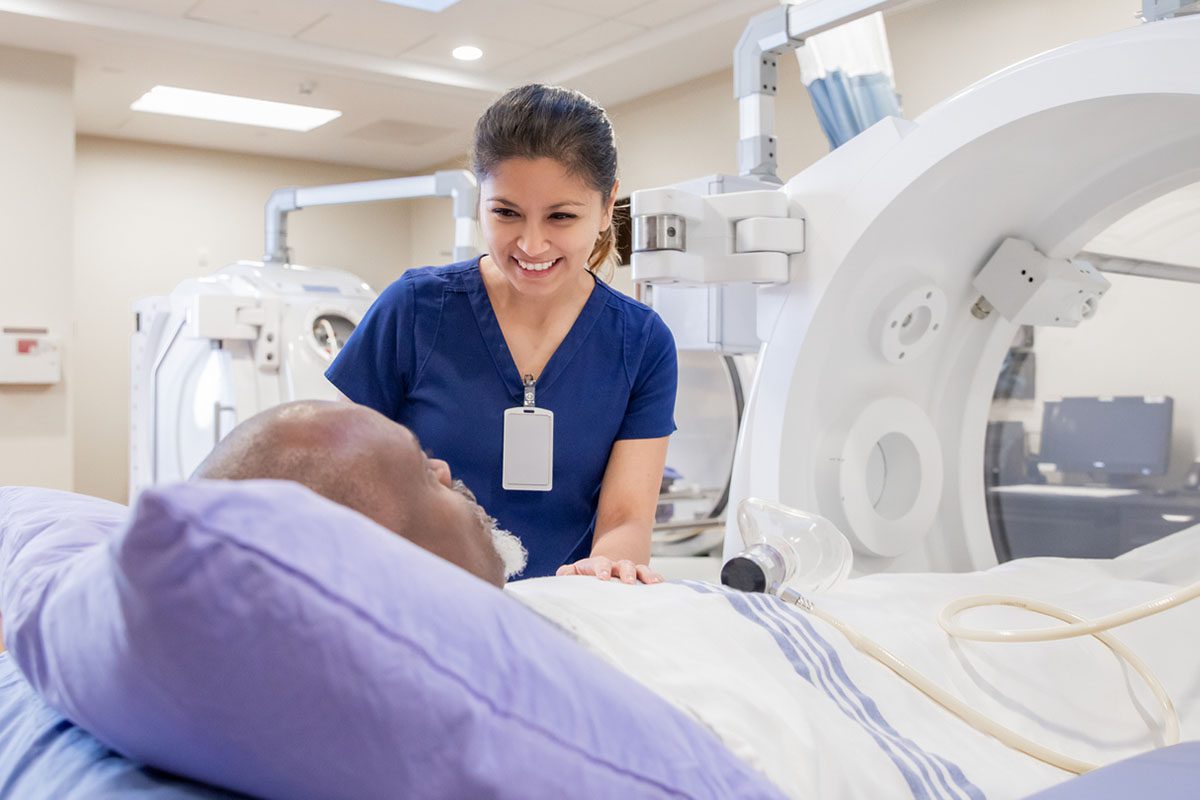ABSTRACT
Objective: The associations between the sequelae of complex trauma symptoms and adult health status, patient engagement in treatment, and the potential impacts on primary care providers are underappreciated despite the potential for adverse outcomes. This study examined the correlations among adult primary care patients’ reports of posttraumatic stress symptoms (PTSS), adverse childhood experiences (ACE), and the impacts of social determinants of health (SDH) with provider diagnoses in the electronic health record.
Methods: Patients in 3 primary care clinics were surveyed. Self-report measures included demographics, trauma symptoms, ACE, and SDH elements. Participant health status and diagnoses were obtained from their electronic health records.
Results: The final sample of 354 participants reported high levels of trauma including PTSS and ACE. Educational attainment, health literacy, material hardship, access to health care, and ACE were all statistically associated with reports of PTSS (P < .05 for all). Despite the prevalence of symptoms and adverse experiences reported by the participants, only 5% were diagnosed with a trauma-related disorder in the electronic health record.
Conclusions: Data analyses revealed a significant discrepancy between participants’ reports of symptoms with a diagnosis of posttraumatic stress disorder by their primary care doctor. Trauma-impacted patients often present with complicated health problems that may influence the encounter in negative ways, including diminishing the primary care doctor’s sense of efficacy and competency if they are not addressed effectively in the encounter. The common nature of ACE, PTSS, and SDH effects indicate that both patients and physicians would benefit from detection and training in strategies for routinely implementing trauma-informed practices.
Prim Care Companion CNS Disord 2021;23(3):20m02781
To cite: Coon KA, Miller-Cribbs J, Wen F, et al. Detecting and addressing trauma-related sequelae in primary care. Prim Care Companion CNS Disord. 2021;23(3):20m02781.
To share: https://doi.org/10.4088/PCC.20m02781
© Copyright 2021 Physicians Postgraduate Press, Inc.
aDepartment of Psychiatry, The OU-TU School of Community Medicine, Tulsa, Oklahoma
bAnne and Henry Zarrow School of Social Work, University of Oklahoma, Norman, Oklahoma
cDepartment of Family and Community Medicine, The OU-TU School of Community Medicine, Tulsa, Oklahoma
dDepartment of Internal Medicine, The OU-TU School of Community Medicine, Tulsa, Oklahoma
*Corresponding author: Kim A. Coon, EdD, Department of Psychiatry, The OU-TU School of Community Medicine, 4502 East 41st St, Tulsa, OK 74135 ([email protected]).
Find more articles on this and other psychiatry and CNS topics:
The Journal of Clinical Psychiatry
The Primary Care Companion for CNS Disorders
CME Background
Articles are selected for credit designation based on an assessment of the educational needs of CME participants, with the purpose of providing readers with a curriculum of CME articles on a variety of topics throughout each volume. Activities are planned using a process that links identified needs with desired results.
To obtain credit, read the article, correctly answer the questions in the Posttest, and complete the Evaluation. This activity is free.
CME Learning Objective/Clinical Strategy:
After studying this article, you should be able to:
- Implement trauma-informed practices
Accreditation Statement
The CME Institute of Physicians Postgraduate Press, Inc., is accredited by the Accreditation Council for Continuing Medical Education to provide continuing medical education for physicians.
Credit Designation
The CME Institute of Physicians Postgraduate Press, Inc., designates this journal-based CME activity for a maximum of 1.0 AMA PRA Category 1 Credit™. Physicians should claim only the credit commensurate with the extent of their participation in the activity.
Note: The American Nurses Credentialing Center (ANCC) and the American Academy of Physician Assistants (AAPA) accept certificates of participation for educational activities certified for AMA PRA Category 1 Credit™ from organizations accredited by the ACCME.
Release, Expiration, and Review Dates
This educational activity was published in June 2021 and is eligible for AMA PRA Category 1 Credit™ through June 30, 2023. The latest review of this material was June 2021.
Financial Disclosure
All individuals in a position to influence the content of this activity were asked to complete a statement regarding all relevant personal financial relationships between themselves or their spouse/partner and any commercial interest. The CME Institute has resolved any conflicts of interest that were identified. In the past year, Larry Culpepper, MD, MPH, Editor in Chief, has been a consultant for AbbVie, Acadia, Allergan, Eisai, Merck, and Takeda; has been a stock shareholder of M-3 Information; and has received royalties from UpToDate and Oxford University Press. No member of the CME Institute staff reported any relevant personal financial relationships. Faculty financial disclosure appears at the end of the article.
The US health care system needs significant change to address rising health care costs while also improving patient health outcomes. Some researchers predict up to 49% of Americans will suffer from chronic health conditions (defined as incurable illnesses or conditions) by 2025.1 Patients with chronic health problems are high utilizers of health care services and account for a large portion of health spending in the United States.2 Adverse childhood experiences (ACE) and other childhood traumas have negative health impacts on patients’ neurologic, physical, and psychological development, which translate to poor overall health and functioning in adulthood.3–5 Complex trauma and interrelated patient factors lead to increased medical health care utilization.6–8
Associations Between Trauma-related Disorders and Adverse Childhood Experiences
Traumas of any kind can lead to negative health consequences.9 While exposure to a traumatic experience elicits an acute distress reaction or posttraumatic stress symptoms (PTSS) in most individuals, not all individuals will go on to develop a diagnosis of posttraumatic stress disorder (PTSD). A diagnosis of PTSD is made when the constellation of trauma symptoms persist beyond 1 month of the exposure and these symptoms impact the individual’s functioning.10 Some individuals experience symptoms of PTSD that are disabling, but their symptoms are subthreshold, meaning there are not enough symptoms to meet criteria for a diagnosis of PTSD.11,12 Nevertheless, these individuals are suffering with PTSS and chronic, complex trauma sequelae.13,14 Complex PTSD is typically related to a series of events or 1 prolonged event, while PTSD may be diagnosed after 1 event or experience.15 The symptoms of complex PTSD can be more enduring and extreme than those of PTSD, and a clinician may diagnose complex PTSD when a patient has experienced trauma on an ongoing basis.11,12,16 The International Classification of Diseases identifies complex PTSD as a separate condition, although the DSM-5 does not.13,17 There are several factors that create a higher risk for developing PTSS or trauma-related illness like PTSD including previous traumatic experiences such as ACE.18,19 Moreover, individuals who experience early trauma like ACE are more likely to be retraumatized, leading to a greater risk for later developing mental illnesses and PTSS in adulthood.20–24
Trauma-related disorders and PTSS are complex, intense, protracted reactions to various trauma experiences. The biological manifestations of ACE in children and adolescents closely resemble those of patients suffering with traumatic stressors in adulthood.25,26 Evidence regarding the etiology for PTSS and trauma-related diagnoses supports the hypotheses that patient illness and distress arise from an amplified activation of almost every biological system employed for coping, adaptation, and survival.5 Unremitting, high levels of stress coupled with an individual’s inability to discern perceived threat from real threat leads to persistent alerts, which are the potential precursors to vulnerability to medical illness in adulthood.20 Adults who experienced ACE are more apt to experience PTSS and trauma-related disorders because of the preexisting sensitization arising from the disruption of the hypothalamic-pituitary-adrenal axis.24,27
ACE is a well-recognized construct of childhood adversity originally defined by Felitti and colleagues3,4 as experiences of childhood physical, emotional, or sexual abuse; neglect and material hardship; and various types of household dysfunction such as witnessing violence toward the mother, parental separation or divorce, household occurrences of substance abuse issues, parental mental illness, or incarceration. Exposure to any ACE category is counted equally as 1 point, with points totaled for a final adversity score out of a possible score of 10. Adults with high ACE scores (defined as ≥ 4) have a higher risk for chronic poor health and struggles with higher level brain functions such as impulse control, planning, flexible decision-making, emotional regulation, or the ability to focus attention because of the impact of trauma on their brain development.28,29 Numerous studies5,30,31 have found that, for individuals with high ACEs, there are complex interactions between biological processes and social determinants of health (SDH) with strong evidence for linkages to brain dysfunction and chronic illness in adulthood. These struggles are posited to be the result of specific elevated neurotransmitters and fluctuating levels of stress hormones that negatively influence brain structure and functioning.24,32
Posttraumatic Stress Symptoms, Complex Trauma, and Health Care Complexity in Primary Care Settings
A shortage of mental health providers along with the stigma of seeking specialty treatment for mental health illnesses influence where patients seek care.33 Primary care settings are where many patients initially present for evaluation and treatment.34 Although family medicine physicians receive a limited behavioral health curriculum component as part of their residency training, internal medicine residents do not have this requirement.35 Due to this relative dearth of specialized instruction for treating complicated mental health issues related to complex trauma, PTSD, and PTSS, many primary care providers miss detecting and discussing patients’ trauma symptoms and concerns.36,37
ACE results in long-term negative health consequences for adults, yet comprehensive strategies to reduce ACE are in their infancy. Unfortunately, individuals who experience high levels of ACE and PTSS also struggle with poor engagement with primary care health providers, lower health literacy, increased health-risk behaviors, and high medical utilization rates at the most expensive care sites such as emergency care centers.1,2 The lack of trauma-informed practices may lead to insensitive physician reactions to patient disclosures of past or present trauma. Unsympathetic reactions by medical providers increase the severity of PTSS, confirmed in studies of disclosures of sexual assault.38,39 Unaddressed ACE after effects, insensitive responses to disclosures of abuse and violence, and unaddressed PTSS have costly effects on an individual’s ability to function in day-to-day relationships and important endeavors.40 A central component of trauma-informed practice is to seek to prevent the retraumatization of patients.
Adults who experienced high levels of early adversity often present challenges for providers in the primary care settings wherein they most often seek treatment.6,8 Primary care physicians face multiple competing demands during the ambulatory encounter—a situation magnified in practices in which the population may be at high risk for trauma and who concurrently experience other sources of adversity such as socioeconomic vulnerability. Studies of medical records found that primary care physicians often fail to uncover PTSD diagnoses or develop treatment plans to address PTSS for their patients.41 Further elucidation of the association between trauma symptomatology, ACE, and SDH in vulnerable primary care populations is warranted to inform the clinical impact of caring for patients with trauma sequelae.
METHODS
Description
This cross-sectional study was conducted at the University of Oklahoma School of Community Medicine internal medicine, family medicine, and community health clinics. The community health clinic is a faculty-supervised student-run clinic for the uninsured or underinsured. The study was approved by the university’s institutional review board. Written consent was obtained, and a $10 gift card was provided for participation. Inclusion criteria included being aged ≥ 18 years and currently enrolled in one of the identified primary care clinics. Participants completed the questionnaire individually, or a member of the research team interviewed the participant and recorded the responses if needed. The questionnaire and interviews were available in Spanish. On average, participation took 20–30 minutes. The data were collected from participants in June through August 2012.
Data were entered and cross-checked for accuracy. Duplicates or respondents who did not fit the inclusion criteria were omitted from the final sample. The final sample included 354 clinic patients from internal medicine (n = 173), family medicine (n = 116), and community health (n = 60).
Study Measures
The survey assessed demographic factors such as age, sex, ethnicity, education, and health literacy, as well as potential sources of adversity including health care barriers, social support, community problems, material hardship, and food insecurity (Table 1). Measures of support or adversity and health literacy were assessed through rating confidence in completing medical forms.42 Material hardships were measured using an adapted form of the Survey of Income and Program Participation43 intended to measure the extent of severity in households experiencing physical hardship. Health care barriers were assessed with questions about having a regular primary care provider or lack of access to health care due to financial or insurance constraints. Social support was measured using the emotional support scale of the Medical Outcomes Study 36-item Short-form Health Survey,44 with higher scores indicating higher social support. Community problems measured participants’ perceptions of adversity in the communities in which they reside, such as vandalism, crime, and abandoned homes. History of intimate partner violence was assessed by questions about ever experiencing in a relationship physical aggression (eg, slapped, kicked, choked), forced or coerced sex, threat by gun or knife, feeling afraid of physical injury, feeling frightened by verbal aggression (eg, screaming), and other verbal harm (eg, threats, put downs). ACE scores were obtained from the ACE questionnaire responses based on the 10 items cited by the seminal ACE study.3 PTSS was measured using the Primary Care PTSD (PC-PTSD) screener.45 Participants’ electronic health records were reviewed for medical history and diagnoses by a physician blinded to the participants’ ACE and adversity status.
Analysis
A series of χ2 tests of independence was conducted to examine the relationships between levels of ACE reported (0–1, 2–3, 4 or more) with PTSS. A hierarchical multiple regression analysis of participants’ PC-PTSD scores as the dependent variable was conducted to examine the extent to which ACE and other concurrent SDH were associated with PTSS. A hierarchical regression model was used. At the first step of the model, demographic variables and other measures of SDH were included; at the second step, experience of intimate partner violence was included; and the final step included ACE.
RESULTS
The majority of participants had a high school education or less (68%), were White (65%), were > 36 years of age (67%), and were female (75%). Specific demographic results from these data are reported in Table 1.46
Participants reported experiences of adverse SDH such as high levels of community struggles, housing problems, food insecurity, barriers to health care, low levels of health literacy, and material hardship in the previous 12 months (Table 2). The mean ACE score was 3.15, with respondents reporting significant PTSD symptoms including nightmares, avoidance, hypervigilance, and numbing (Table 3). Respondents who reported PTSS of numbness or detachment, hypervigilance, nightmares, and avoidance had statistically higher ACE scores. Over one-half of the sample reported 1 or more symptoms of PTSS on the PC-PTSD measure. The PTSS sum score was statistically associated with higher ACE scores (Table 4).
A comparison of the participants’ scores on the PC-PTSD with a diagnosis of PTSD recorded in the electronic health record revealed an inconsistency between patients’ significant reports of trauma-related symptoms and the physicians’ diagnostic findings. Five percent of the sample had a diagnosis of PTSD recorded in the electronic health record; however, a little over half of the sample indicated 1 or more trauma symptoms, with 22% reporting all symptoms on the PC-PTSD scale. Specifically, 35% of the participants reported nightmares/intrusive nightmares, 41% reported avoidance behaviors, 35% reported hypervigilance, and 33% reported detachment/numbing. Over one-third of the participants reported 3 or more PTSS, indicating a potential clinical diagnosis of PTSD.45
The first step in the hierarchical regression model included demographic variables such as ethnicity, age, sex, and education, as well as other SDH such as health care barriers, health literacy, social support, community problems, material hardship, and receipt of food stamps, accounting for 22% of the variance. All variables predicted PTSS, except age, sex, and ethnicity. At the second step, intimate partner violence predicted PTSS, with this model accounting for 24% of the variance. When the ACE summary score was included in the final model, 37% of the variance in PTSS symptoms was accounted for overall, and the ACE score was the strongest predictor. While social support, community problems, and receipt of food stamps were associated with PTSS in this model, these variables were not significantly associated with PTSS once ACE was included in the next model. The other independent variables significantly related to PTSS were education, health literacy, health care barriers, and material hardship (Table 5).
DISCUSSION
This research found prevalent PTSS that was underdiagnosed in a vulnerable primary care population. PTSS was found to be significantly associated with sources of adversity—notably ACE as well as education, health literacy, health care barriers, and material hardship. When added to the final model, ACE accounted for most of the variance in PTSS.
In aggregate, our study extends previous work on the associations between ACE and trauma symptomatology investigated with SDH.47 Our findings have important implications not only for the clinical effects on patients, but also for primary care providers and health systems. In particular, our results reinforce the need for trauma-informed primary care practices including a more thorough exploration of complex trauma effects on patients presenting for treatment.48 Our findings suggest that it is important to assess specifically for historical (eg, ACE) and concurrent (eg, material hardship, community problems) sources of adversity to effectively work with patients’ PTSS. Trauma-informed care includes trauma-sensitive interviewing, assessment of SDH, and use of treatment practices that acknowledge the effects of trauma on a patient’s chronic health conditions that will influence the utilization of services and the patient’s capacity for engaging in treatment.49–51
Provision of care for patients with a history of ACE, intimate partner violence, and trauma symptomatology adds to the challenge of treating chronic health conditions in the primary care setting because of the many layers of complicated issues patients bring to the encounter.19,52 Ability to address the complexity of the health and behavioral problems of these patients in the typical encounter is also impacted by visit time constraints as well as the patients’ struggles with trusting their providers.7 Appreciating the impact of PTSS on adult health and then intervening effectively and appropriately are key features for improving provider sense of competency while also positively impacting health care outcomes. While knowledge about the occurrence of PTSS in primary care clinic populations has increased, models for addressing trauma sequelae in primary care settings have lagged behind. Promising trauma-informed interventions have not been extensively, or significantly, implemented into most primary care training settings.
In the context of the extant research regarding ACE-related chronic health outcomes, our findings further affirm the importance of using population health management to identify groups of patients who may be at higher risk for medical illness, addiction disorders, disability, social dysfunction, and poor engagement in treatment.7,23,32 Intervening with those adult patients who experienced multiple ACE who also endorse PTSS can positively affect engagement with providers and enhance clinical outcomes such as following treatment recommendations.40,53,54
Trauma-informed discussions of PTSS effects on adult patient health may decrease future maladaptive reactions to environmental stressors that lead to physical and social dysfunction, including the inability to fully engage in health prevention activities or participate in continuity of care and treatment planning.49–51 Adoption of trauma-informed care practices shows promise for improving patient engagement, treatment adherence, and health outcomes, as well as provider and staff wellness.55 With the addition of effective provider training in communication skills and education in trauma-informed communication, it is hypothesized that physicians will approach patients with complicated trauma with a sense of competency and compassion.46,56–58
Because of our previous findings that high rates of PTSS, ACE, and SDH are strongly associated with negative health effects, our team created and implemented a training intervention for our primary care faculty members, resident physicians, and medical students. Our training is one of the growing efforts in the United States to build trauma-informed medical education, with recent efforts to coalesce educators through a national collaborative on Trauma-Informed Health Care Education and Research (https://www.trauma-informedcare.com/).
There are limitations that should be considered when interpreting the findings in our study. Recall bias may have influenced participant responses; however, the direction of the bias cannot be determined. Previous studies of ACE findings note that patients were more likely to underreport adversity in childhood.58 Geographic location and research conducted in university-based clinics may also limit generalizability to other practice venues.
In summary, our finding that ACE and trauma symptomatology are related to SDH advances previous work in this area and has significant implications for clinical practice and training of health care professionals in primary care settings. Among the many existing challenges of practice in primary care, addressing the needs of patients with a history of ACE and trauma is key to improved patient outcomes and engagement. Educational and health systems models that address ACE and trauma in primary care using population health management strategies to identify at-risk patients are needed.
Submitted: August 8, 2020; accepted December 17, 2020.
Published online: June 17, 2021.
Disclosure of off-label usage: The authors have determined that, to the best of their knowledge, no investigational information about pharmaceutical agents or device therapies that is outside US Food and Drug Administration–approved labeling has been presented in this article.
Financial disclosure: Drs Coon, Miller-Cribbs, Wen, and Jelley and Ms Sutton have no personal affiliations or financial relationships with any commercial interest to disclose relative to the article.
Funding/support: Research reported in this publication was supported in part by the US Health Resources and Services Administration (HRSA), Bureau of Health Professions, Academic Administrative Units Award No. D54HP05259; the Academy of Teaching Scholars, College of Medicine, University of Oklahoma Health Sciences Center; and the Telligen Community Initiative, Healthcare Workforce Development Program.
Role of the sponsor: The sponsors had no role in the design and conduct of the study; collection, management, analysis, and interpretation of data; or preparation, review, or approval of the manuscript.
Clinical Points
- Identification of effective primary care trauma-informed approaches that address the effects of posttraumatic stress symptoms will advance medical treatment of adults who are most at risk for chronic health conditions and the prevalent adverse childhood experience sequelae including chronic, complex trauma symptoms.
- Successful trauma-informed primary care practices should acknowledge social determinants of health and patients’ experiences of trauma including impacts of adverse childhood experiences in to provide effective health care services that both facilitate and inspire patients’ sense of safety and trust.
References (59)

- Wu S, Green A. Projection of Chronic Illness Prevalence and Cost Inflation. RAND Corp; 2000.
- About Chronic Center for Disease Control and Prevention. 2018. Accessed May 14, 2021. www.cdc.gov/chronicdisease/about/index.htm
- Felitti VJ, Anda RF, Nordenberg D, et al. Relationship of childhood abuse and household dysfunction to many of the leading causes of death in adults: the Adverse Childhood Experiences (ACE) Study. Am J Prev Med. 1998;14(4):245–258. PubMed CrossRef
- Anda RF, Felitti VJ, Bremner JD, et al. The enduring effects of abuse and related adverse experiences in childhood: a convergence of evidence from neurobiology and epidemiology. Eur Arch Psychiatry Clin Neurosci. 2006;256(3):174–186. PubMed CrossRef
- Maniam J, Antoniadis C, Morris MJ. Early-life stress, HPA axis adaptation, and mechanisms contributing to later health outcomes. Front Endocrinol (Lausanne). 2014;5:73. PubMed CrossRef
- Arnow BA. Relationships between childhood maltreatment, adult health and psychiatric outcomes, and medical utilization. J Clin Psychiatry. 2004;65(suppl 12):10–15. PubMed
- Gillock KL, Zayfert C, Hegel MT, et al. Posttraumatic stress disorder in primary care: prevalence and relationships with physical symptoms and medical utilization. Gen Hosp Psychiatry. 2005;27(6):392–399. PubMed CrossRef
- Bonomi AE, Anderson ML, Rivara FP, et al. Health care utilization and costs associated with childhood abuse. J Gen Intern Med. 2008;23(3):294–299. PubMed CrossRef
- Schnurr PP, Green BL, eds. Trauma and Health: Physical Health Consequences of Exposure to Extreme Stress. Washington, DC: American Psychological Association. 2004;12:311.
- American Psychiatric Association. Diagnostic and Statistical Manual for Mental Disorders. Fifth Edition. Washington, DC: American Psychiatric Association; 2013.
- McLaughlin KA, Koenen KC, Friedman MJ, et al. Subthreshold posttraumatic stress disorder in the World Health Organization World Mental Health Surveys. Biol Psychiatry. 2015;77(4):375–384. PubMed CrossRef
- Frewen P, Zhu J, Lanius R. Lifetime traumatic stressors and adverse childhood experiences uniquely predict concurrent PTSD, complex PTSD, and dissociative subtype of PTSD symptoms whereas recent adult non-traumatic stressors do not: results from an online survey study. Eur J Psychotraumatol. 2019;10(1):1606625. PubMed CrossRef
- Brewin CR, Cloitre M, Hyland P, et al. A review of current evidence regarding the ICD-11 proposals for diagnosing PTSD and complex PTSD. Clin Psychol Rev. 2017;58:1–15. PubMed CrossRef
- Kliethermes M, Schacht M, Drewry K. Complex trauma. Child Adolesc Psychiatr Clin N Am. 2014;23(2):339–361, ix. PubMed CrossRef
- Forman-Hoffman VL, Bose J, Batts KR, et al. Correlates of lifetime exposure to one or more potentially traumatic events and subsequent posttraumatic stress among adults in the United States: results from the Mental Health Surveillance Study, 2008–2012. In: CBHSQ Data Review. Rockville, MD: Substance Abuse and Mental Health Services Administration; 2016.
- Elklit A, Hyland P, Shevlin M. Evidence of symptom profiles consistent with posttraumatic stress disorder and complex posttraumatic stress disorder in different trauma samples. Eur J Psychotraumatol. 2014;5:10.3402/ejpt.v5.24221. PubMed
- Karatzias T, Shevlin M, Fyvie C, et al. Evidence of distinct profiles of posttraumatic stress disorder (PTSD) and complex posttraumatic stress disorder (CPTSD) based on the new ICD-11 Trauma Questionnaire (ICD-TQ). J Affect Disord. 2017;207:181–187. PubMed CrossRef
- Cloitre M, Khan C, Mackintosh MA, et al. Emotion regulation mediates the relationship between ACES and physical and mental health. Psychol Trauma. 2019;11(1):82–89. PubMed CrossRef
- De Jongh A, Resick PA, Zoellner LA, et al. Critical analysis of the current treatment guidelines for complex PTSD in adults. Depress Anxiety. 2016;33(5):359–369. PubMed
- Yehuda R, Flory JD, Pratchett LC, et al. Putative biological mechanisms for the association between early life adversity and the subsequent development of PTSD. Psychopharmacology (Berl). 2010;212(3):405–417. PubMed CrossRef
- Bremner JD, Elzinga B, Schmahl C, et al. Structural and functional plasticity of the human brain in posttraumatic stress disorder. Prog Brain Res. 2008;167:171–186. PubMed CrossRef
- Cohen H, Matar MA, Richter-Levin G, et al. The contribution of an animal model toward uncovering biological risk factors for PTSD. Ann N Y Acad Sci. 2006;1071(1):335–350. PubMed CrossRef
- Bomyea J, Risbrough V, Lang AJ. A consideration of select pre-trauma factors as key vulnerabilities in PTSD. Clin Psychol Rev. 2012;32(7):630–641. PubMed CrossRef
- Raabe FJ, Spengler D. Epigenetic risk factors in PTSD and depression. Front Psychiatry. 2013;4:80. PubMed CrossRef
- Iribarren J, Prolo P, Neagos N, et al. Post-traumatic stress disorder: evidence-based research for the third millennium. Evid Based Complement Alternat Med. 2005;2(4):503–512. PubMed CrossRef
- Agorastos A, Pervanidou P, Chrousos GP, et al. Developmental trajectories of early life stress and trauma: a narrative review of neurobiological aspects beyond stress system dysregulation. Front Psychiatry. 2019;10:118. PubMed CrossRef
- Klaassens ER, van Noorden MS, Giltay EJ, et al. Effects of childhood trauma on HPA-axis reactivity in women free of lifetime psychopathology. Prog Neuropsychopharmacol Biol Psychiatry. 2009;33(5):889–894. PubMed CrossRef
- Sheffield JM, Williams LE, Woodward ND, et al. Reduced gray matter volume in psychotic disorder patients with a history of childhood sexual abuse. Schizophr Res. 2013;143(1):185–191. PubMed CrossRef
- Mickley Steinmetz KR, Scott LA, Smith D, et al. The effects of trauma exposure and posttraumatic stress disorder (PTSD) on the emotion-induced memory trade-off. Front Integr Nuerosci. 2012;6:34. PubMed
- Franz HM, Corbo V, Fonda JR, et al. The impact of interpersonal early life trauma on cardio-metabolic health in post-9/11 veterans. Health Psychol. 2019;38(2):113–121. PubMed CrossRef
- Shonkoff JP, Boyce WT, McEwen BS. Neuroscience, molecular biology, and the childhood roots of health disparities: building a new framework for health promotion and disease prevention. JAMA. 2009;301(21):2252–2259. PubMed CrossRef
- Gerson R, Rappaport N. Traumatic stress and posttraumatic stress disorder in youth: recent research findings on clinical impact, assessment, and treatment. J Adolesc Health. 2013;52(2):137–143. PubMed CrossRef
- Knaak S, Mantler E, Szeto A. Mental illness-related stigma in healthcare: Barriers to access and care and evidence-based solutions. Healthc Manage Forum. 2017;30(2):111–116. PubMed CrossRef
- Brock CD, Johnson AH, Koopman RJ, et al. Difficult doctor-patient relationships that cause diagnostic and management dilemmas. J Balint Soc. 2006;33:6–10.
- Freedy JR, Brock CD. Spotting-and treating-PTSD in primary care. J Fam Pract. 2010;59(2):75–80. PubMed
- Meredith LS, Eisenman DP, Green BL, et al. System factors affect the recognition and management of posttraumatic stress disorder by primary care clinicians. Med Care. 2009;47(6):686–694. PubMed CrossRef
- Ehlers A, Gene-Cos N, Perrin S. Low recognition of posttraumatic stress disorder in primary care. London J Prim Care (Abingdon). 2009;2(1):36–42. PubMed CrossRef
- Edwards KM, Dardis CM. Disclosure recipients’ social reactions to victims’ disclosures of intimate partner violence. J Interpers Violence. 2020;35(1–2):53–76. PubMed CrossRef
- Amin P, Buranosky R, Chang JC. Physicians’ perceived roles, as well as barriers, toward caring for women sex assault survivors. Womens Health Issues. 2017;27(1):43–49. PubMed CrossRef
- Shalev AY, Ankri Y, Israeli-Shalev Y, et al. Prevention of posttraumatic stress disorder by early treatment: results from the Jerusalem Trauma Outreach And Prevention study. Arch Gen Psychiatry. 2012;69(2):166–176. PubMed CrossRef
- Liebschutz J, Saitz R, Brower V, et al. PTSD in urban primary care: high prevalence and low physician recognition. J Gen Intern Med. 2007;22(6):719–726. PubMed CrossRef
- Chew LD, Griffin JM, Partin MR, et al. Validation of screening questions for limited health literacy in a large VA outpatient population. J Gen Intern Med. 2008;23(5):561–566. PubMed CrossRef
- Ouellette T, Burstein N, Long D, et al. Measures of material hardship: Final report. US Department of Health and Human Services. 2004. https://aspe.hhs.gov/report/measures-material-hardship-final-report
- Ware JE Jr, Sherbourne CD. The MOS 36-item Short-Form Health Survey (SF-36). I. Conceptual framework and item selection. Med Care. 1992;30(6):473–483. PubMed CrossRef
- Prins A, Ouimette P, Kimerling R, et al. The Primary Care PTSD screen (PC-PTSD): development and operating characteristics. Prim Care Psychiatry. 2003;9(1):9–14. CrossRef
- Jelley M, Wen F, Miller-Cribbs J, et al. Adverse childhood experiences, other psychosocial sources of adversity, and quality of life in vulnerable primary care patients. Perm J. 2020;24:18.277. PubMed
- Merrick MT, Ford DC, Ports KA, et al. Vital signs: Estimated proportion of adult health problems attributable to adverse childhood experiences and implications for prevention—25 States, 2015–2017. MMWR Morb Mortal Wkly Rep. 2019;68(44):999–1005. PubMed CrossRef
- Machtinger EL, Cuca YP, Khanna N, et al. From treatment to healing: the promise of trauma-informed primary care. Womens Health Issues. 2015;25(3):193–197. PubMed CrossRef
- Hamberger KL, Courtney Barry C, Franco C. Implementing trauma-informed care in primary medical settings: evidence-based rationale and approaches. J Aggress Maltreat Trauma. 2019;28(4):425–444. CrossRef
- Machtinger EL, Davis KB, Kimberg LS, et al. From treatment to healing: inquiry and response to recent and past trauma in adult health care. Womens Health Issues. 2019;29(2):97–102. PubMed CrossRef
- Weinreb L, Savageau JA, Candib LM, et al. Screening for childhood trauma in adult primary care patients: a cross-sectional survey. Prim Care Companion J Clin Psychiatry. 2010;12(6):PCC.10m00950. PubMed
- Goldstein E, Athale N, Sciolla AF, et al. Patient preferences for discussing childhood trauma in primary care. Perm J. 2017;21:16-055. PubMed CrossRef
- Dichter ME, Teitelman A, Klusaritz H, et al. Trauma-informed care training in family medicine residency programs: results from a CERA survey. Fam Med. 2018;50(8):617–622. PubMed CrossRef
- Leibowitz KA, Hardebeck EJ, Goyer JP, et al. Physician reassurance reduces patient symptoms in US adults: an experimental study. J Gen Intern Med. 2018;33(12):2051–2052. PubMed CrossRef
- Green BL, Saunders PA, Power E, et al. Trauma-informed medical care: patient response to a primary care provider communication training. J Loss Trauma. 2016;21(2):147–159. PubMed CrossRef
- Hull SK, Broquet K. How to manage difficult patients. Fam Pract Manag. 2007;14(6):31–34. PubMed
- Wen FK, Miller-Cribbs JE, Coon KA, et al. A simulation and video-based training program to address adverse childhood experiences. Int J Psychiatry Med. 2017;52(3):255–264. PubMed CrossRef
- Miller-Cribbs J, Bragg J, Wen F, et al. An evaluation of a simulation and video-based training program to address adverse childhood experiences. Int J Psychiatry Med. 2020;55(5):366–375. PubMed CrossRef
- McKinney CM, Harris TR, Caetano R. Reliability of self-reported childhood physical abuse by adults and factors predictive of inconsistent reporting. Violence Vict. 2009;24(5):653–668. PubMed CrossRef
Please sign in or purchase this PDF for $40.
